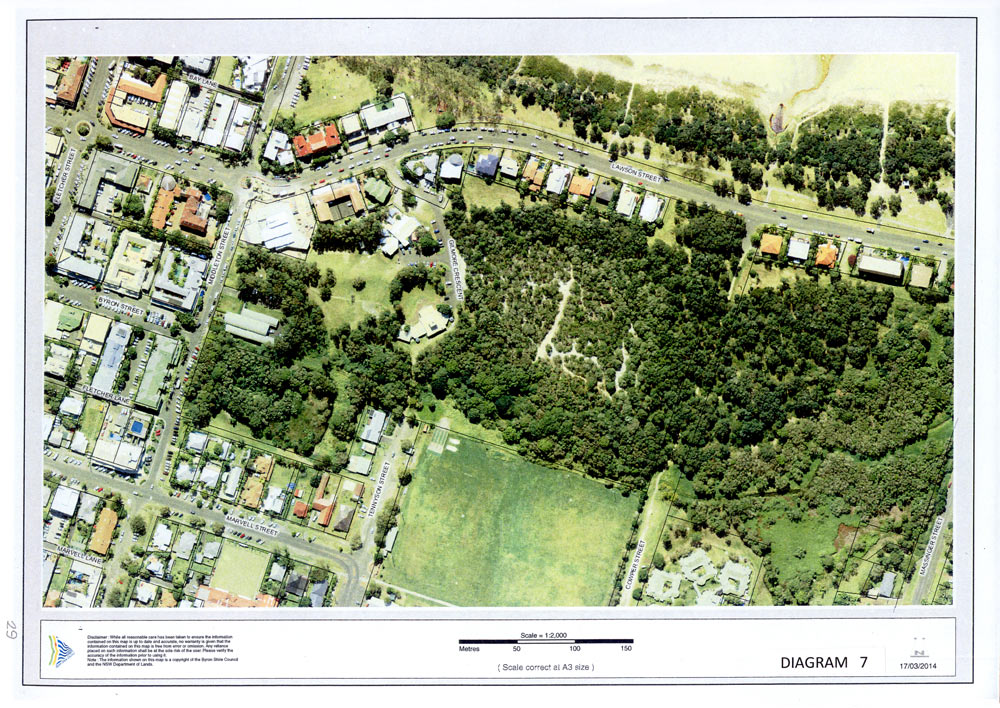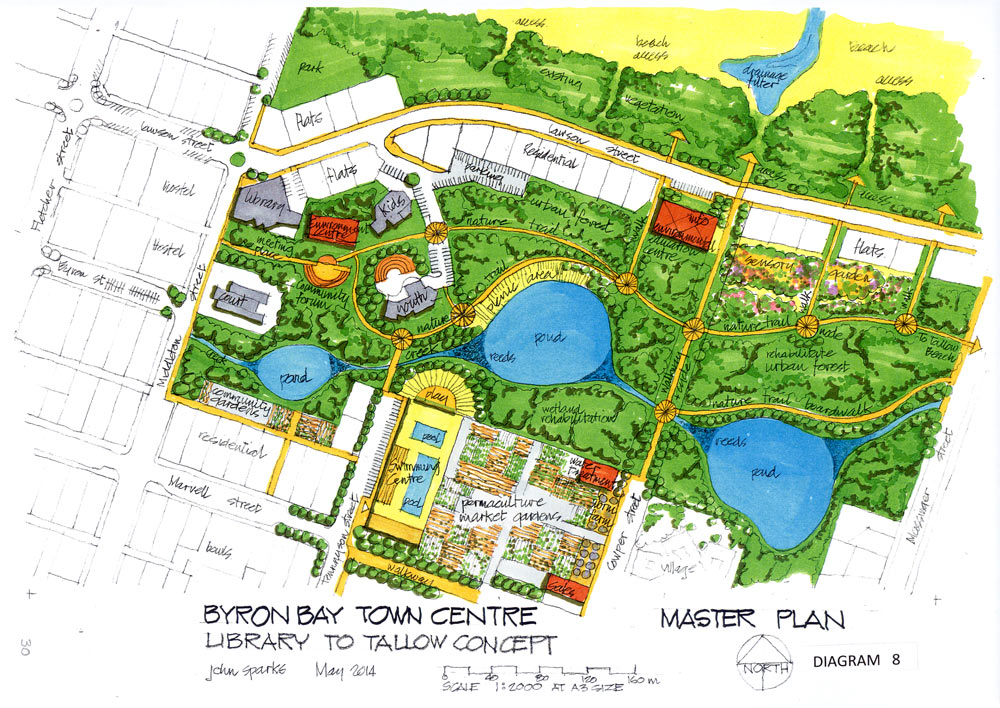EXISTING CONSTRAINTS
The area shown on photo diagram No 7 extends from Middleton Street to eventually lead through the coastal heath and National Park to Tallow Beach. It is contained by the existing residential buildings along Lawson Street and extends south to the existing sports fields and residential area.
The western area is accessed from Middleton Street and contains the library, Court House, Child Care Centre and the Youth Activities Centre with their associated car parking and Service areas. The central area contains wetland trees and planting which has been degraded by the neglect, occupation and transit of people and cars and the eastern wetland area through to Massinger Street is overgrown in some places and cleared in other areas behind the dwellings.
There are isolated pockets of lush growth south of the Court House and along some creek areas. The natural stormwater drainage from the town centre transits this area with a discharge point to the beach at Cowper Street and other creeks which are now no more than drainage channels, progressing through the site towards Tallow Beach.
The football oval and sports facilities to the south of this wetland have been cleared and actively maintained.
POTENTIAL
This area already contains many community buildings and has the potential:-
-
- to become a communal area for local activities
- to provide a natural focus for the local community away from commercialism
- to be a meeting place for community forums
- to cater for active and passive recreation
- to rehabilitate the degraded wetlands
- to create an urban forest
- to enhance the riparian zones along the creeks
- to manage and store stormwater
- to provide ponds for natural treatment of stormwater
- to provide a grey water recycling system to service the town centre
- to allow quiet picnic and recreation areas
- to teach and learn about the natural environment
- to maintain a natural environment to all adjoining residential areas
- to provide a swimming and water sports centre connected to nature and a water garden
- to produce all the town centre food needs through a permaculture market garden
- to process food waste from the town in a worm farm
- to produce and sell compost
- to propagate all indigenous plants for rehabilitation and sale
- to provide community gardens


- to make nature trails, boardwalks and cycleways through the sensitive wetlands to link the town centre through alternative nature trails and tracks to Tallow Beach
- to provide an interlinked pedestrian network for adventure and discovery tours
- to provide interesting nodes and information points along the walkways and trails
- to link the town area with the Arakwal National Park to encourage Aboriginal input to community to provide a healing garden with yoga and meditation
- to provide a sensory garden with facilities for impaired people
- to provide full access to all areas for people with disabilities
- to incorporate geomancy and restore energy lines under the guidance of the Aboriginal people.
- to connect this area through walkways to Clarkes beach.
DESIGN CONCEPT
The library to Tallow concept is outlined in diagram No 8 which aims to rehabilitate the wetland green areas, create a communal activity area, manage the stormwater, provide food self-sufficiency, provide a swimming and water sports centre and become an environmental research and education venue for Byron.
An active community focus has been created around the library, Courthouse, Child Care and Youth Centres accessible off Middleton Street. This would become a local meeting place with areas for community discussion, education, recreation and ceremony. An environment centre would complement the existing Byron Environment Centre with a focus on the natural environment and sustainability. A small café would complement the nearby eateries and act as a social drawcard.
The emphasis in this area would be on the local community and inclusion of kids, youth, elderly, Aboriginal, disabled and all peoples in their connection with the land.
An environmental education, conference and information centre is shown fronting Lawson Street foreasy access and visibility to encourage the dissemination of local research to the outside world.
All wetland areas and coastal heath are rehabilitated and interspersed with urban forest, green buffer zones, water gardens, discovery gardens, adventure gardens and picnic areas. The area is traversed by nature trails with boardwalks to protect sensitive areas and nodes which create focal points along the way to sit, rest, or connect with a specific landscape feature. Some of these would be active meeting points while others could be quiet meditative places.
The nature trails lead through Massinger Street where they connect with another path that leads through to Tallow beach to the east. Other branch pathways extend north across Lawson Street to provide multiple access points to Clarkes beach. The importance of this area is to integrate all the surrounding areas with the town centre, by connecting to Tallow beach and Clarkes beach and connecting to the residential areas, all through a natural and functional environment.
All pathways and activity areas within this precinct can be made accessible for people with disabilities and incorporated as an integral part of the design. A sensory garden is provided with easy access to Lawson Street for people with disabilities and others to enjoy the full range of sensory experiences through smell, sight, touch, feel and sound that are provided with special plants and sculptures within this garden.
The existing creeks which collect the stormwater from the town centre and surrounding areas discharge to Clarkes beach and the low point in Massinger Street. The degraded creeks have been expanded into a series of ponds to hold and cleanse the water through reed beds and rehabilitated riparian zones before they overflow to external drainage areas. These ponds are generally located in areas where the wetland is degraded or overgrown and will
assist the rehabilitation of their surrounding environment.
During periods of heavy rainfall these ponds will also provide storage capacity and are part of a stormwater management system. All stormwater from the town centre could be piped to these ponds where it would be stored and purified through natural reeds, plants and rocks then filtered and pumped through the water treatment plant shown in Cowper Street to a grey water circulation main servicing the town centre. This simple collect, store, treat and reuse water system is fully sustainable and environmentally
positive.
All buildings could incorporate a grey water system with personal drinking and washing by town water and all other uses such as toilets, cleaning, landscaping and fire using the cheaper grey water. Apart from the stormwater, grey water and wetland rehabilitation functions of these ponds they would enhance the bird life and biodiversity, create visual interest, and give active and passive enjoyment to many people.
Around the central pond a picnic area for family enjoyment is provided and a water play park area attached to the swimming pool opens out to connect with this natural water feature. The new swimming and water sports centre is located on part of the existing sports oval fronting Tennyson Street where generous parking can be provided and to connect the water sports and recreation with the communal pond and natural green areas to the north.
This new water sports facility occupies a larger area than the existing beachfront pool and will allow the provision of a high standard of amenities for both competitive and recreational water sports with a family orientated theme to encourage full community access. The venue is ideal with generous parking and open space connections and no traffic conflicts with tourist movements.
The remaining section of the existing football oval has been used for a permaculture market garden which can supply the fresh food needs of the town, cafes and restaurants as well as selling fresh produce to the public. This would be a fully commercial market garden with organic local produce and zero food miles and zero carbon - a totally sustainable enterprise with many direct local benefits.
In addition, a town centre compostable waste collection system could be established to collect all suitable waste for the commercial worm farm located along Cowper Street. Existing enterprising companies will provide a worm farm to process waste and produce compost and fertiliser on a commercial basis with sales through the shop in Cowper Street.
For local residents a community garden is provided behind the residential buildings in Marvell Street.This can also provide produce for the local community as well as being a meeting place connected to the nearby communal meeting and recreational areas. This major green space is an important part of the town centre structure providing a local
community focus, rehabilitating the wetlands, providing a water management system, creating environmental research and education areas, allowing a significant Water Sports Centre, providing organic produce, allowing pathways linking the town with the beaches and connecting with the diverse surrounding functions of the neighbourhood.
ESSENTIAL COMPONENTS
Within the positive and sustainable uses outlined for this precinct the significant principles that should not be compromised are:-
- the rehabilitation of all wetland areas and biodiversity
- the provision of internal nature trails linking all external areas
- the environmental research and education facilities
- a meeting place for inclusion of the whole community
- a stormwater management, treatment and recycling system
- a first class swimming and water sports centre
- a commercial permaculture market garden with compost and fertiliser recycling.
- The true value of this precinct is in its ability to provide essential community functions in a fully sustainable, zero carbon environment that is so enjoyable and accessible to the major beaches, town centre and neighbourhood areas.